(10.137)
p′ = ⎛⎝1.050 kg⎞⎠(1.20 m)(1.744 rad/s) = 2.20 kg ⋅ m/s.
Discussion
First note that the kinetic energy is less after the collision, as predicted, because the collision is inelastic. More surprising is that the momentum
after the collision is actually greater than before the collision. This result can be understood if you consider how the nail affects the stick and vice
versa. Apparently, the stick pushes backward on the nail when first struck by the disk. The nail’s reaction (consistent with Newton’s third law) is to
push forward on the stick, imparting momentum to it in the same direction in which the disk was initially moving, thereby increasing the
momentum of the system.
The above example has other implications. For example, what would happen if the disk hit very close to the nail? Obviously, a force would be exerted
on the nail in the forward direction. So, when the stick is struck at the end farthest from the nail, a backward force is exerted on the nail, and when it is
hit at the end nearest the nail, a forward force is exerted on the nail. Thus, striking it at a certain point in between produces no force on the nail. This
intermediate point is known as the percussion point.
An analogous situation occurs in tennis as seen in Figure 10.27. If you hit a ball with the end of your racquet, the handle is pulled away from your
hand. If you hit a ball much farther down, for example, on the shaft of the racquet, the handle is pushed into your palm. And if you hit the ball at the
racquet’s percussion point (what some people call the “sweet spot”), then little or no force is exerted on your hand, and there is less vibration,
reducing chances of a tennis elbow. The same effect occurs for a baseball bat.

344 CHAPTER 10 | ROTATIONAL MOTION AND ANGULAR MOMENTUM
Figure 10.27 A disk hitting a stick is compared to a tennis ball being hit by a racquet. (a) When the ball strikes the racquet near the end, a backward force is exerted on the
hand. (b) When the racquet is struck much farther down, a forward force is exerted on the hand. (c) When the racquet is struck at the percussion point, no force is delivered to
the hand.
Check Your Understanding
Is rotational kinetic energy a vector? Justify your answer.
Solution
No, energy is always scalar whether motion is involved or not. No form of energy has a direction in space and you can see that rotational kinetic
energy does not depend on the direction of motion just as linear kinetic energy is independent of the direction of motion.
10.7 Gyroscopic Effects: Vector Aspects of Angular Momentum
Angular momentum is a vector and, therefore, has direction as well as magnitude. Torque affects both the direction and the magnitude of angular
momentum. What is the direction of the angular momentum of a rotating object like the disk in Figure 10.28? The figure shows the right-hand rule used to find the direction of both angular momentum and angular velocity. Both L and ω are vectors—each has direction and magnitude. Both can
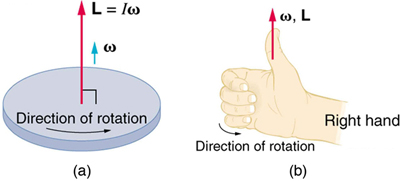
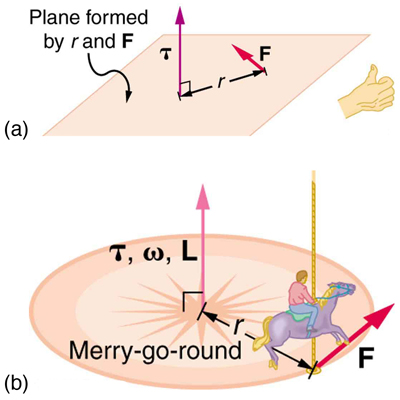
CHAPTER 10 | ROTATIONAL MOTION AND ANGULAR MOMENTUM 345
be represented by arrows. The right-hand rule defines both to be perpendicular to the plane of rotation in the direction shown. Because angular
momentum is related to angular velocity by L = Iω , the direction of L is the same as the direction of ω . Notice in the figure that both point along the axis of rotation.
Figure 10.28 Figure (a) shows a disk is rotating counterclockwise when viewed from above. Figure (b) shows the right-hand rule. The direction of angular velocity ω size and angular momentum L are defined to be the direction in which the thumb of your right hand points when you curl your fingers in the direction of the disk’s rotation as shown.
Now, recall that torque changes angular momentum as expressed by
(10.138)
net τ = ΔL
Δ t .
This equation means that the direction of ΔL is the same as the direction of the torque τ that creates it. This result is illustrated in Figure 10.29,
which shows the direction of torque and the angular momentum it creates.
Let us now consider a bicycle wheel with a couple of handles attached to it, as shown in Figure 10.30. (This device is popular in demonstrations
among physicists, because it does unexpected things.) With the wheel rotating as shown, its angular momentum is to the woman's left. Suppose the
person holding the wheel tries to rotate it as in the figure. Her natural expectation is that the wheel will rotate in the direction she pushes it—but what
happens is quite different. The forces exerted create a torque that is horizontal toward the person, as shown in Figure 10.30(a). This torque creates a change in angular momentum L in the same direction, perpendicular to the original angular momentum L , thus changing the direction of L but
not the magnitude of L . Figure 10.30 shows how ΔL and L add, giving a new angular momentum with direction that is inclined more toward the person than before. The axis of the wheel has thus moved perpendicular to the forces exerted on it, instead of in the expected direction.
Figure 10.29 In figure (a), the torque is perpendicular to the plane formed by r and F and is the direction your right thumb would point to if you curled your fingers in the direction of F . Figure (b) shows that the direction of the torque is the same as that of the angular momentum it produces.
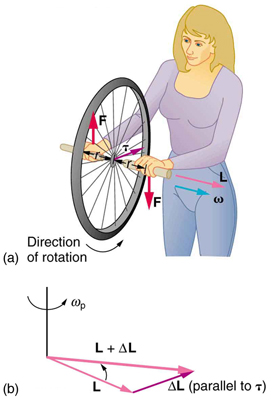
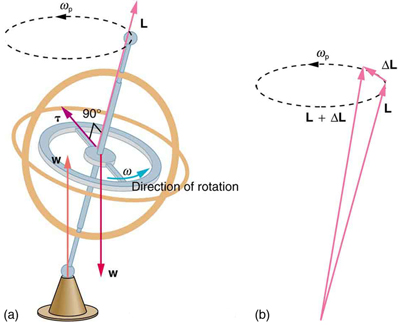
346 CHAPTER 10 | ROTATIONAL MOTION AND ANGULAR MOMENTUM
Figure 10.30 In figure (a), a person holding the spinning bike wheel lifts it with her right hand and pushes down with her left hand in an attempt to rotate the wheel. This action creates a torque directly toward her. This torque causes a change in angular momentum ΔL in exactly the same direction. Figure (b) shows a vector diagram depicting how
ΔL and L add, producing a new angular momentum pointing more toward the person. The wheel moves toward the person, perpendicular to the forces she exerts on it.
This same logic explains the behavior of gyroscopes. Figure 10.31 shows the two forces acting on a spinning gyroscope. The torque produced is
perpendicular to the angular momentum, thus the direction of the torque is changed, but not its magnitude. The gyroscope precesses around a
vertical axis, since the torque is always horizontal and perpendicular to L . If the gyroscope is not spinning, it acquires angular momentum in the
direction of the torque ( L = ΔL ), and it rotates around a horizontal axis, falling over just as we would expect.
Earth itself acts like a gigantic gyroscope. Its angular momentum is along its axis and points at Polaris, the North Star. But Earth is slowly precessing
(once in about 26,000 years) due to the torque of the Sun and the Moon on its nonspherical shape.
Figure 10.31 As seen in figure (a), the forces on a spinning gyroscope are its weight and the supporting force from the stand. These forces create a horizontal torque on the
gyroscope, which create a change in angular momentum ΔL that is also horizontal. In figure (b), ΔL and L add to produce a new angular momentum with the same
magnitude, but different direction, so that the gyroscope precesses in the direction shown instead of falling over.
Check Your Understanding
Rotational kinetic energy is associated with angular momentum? Does that mean that rotational kinetic energy is a vector?
Solution
No, energy is always a scalar whether motion is involved or not. No form of energy has a direction in space and you can see that rotational
kinetic energy does not depend on the direction of motion just as linear kinetic energy is independent of the direction of motion.
Glossary
angular acceleration: the rate of change of angular velocity with time
CHAPTER 10 | ROTATIONAL MOTION AND ANGULAR MOMENTUM 347
angular momentum: the product of moment of inertia and angular velocity
change in angular velocity: the difference between final and initial values of angular velocity
kinematics of rotational motion: describes the relationships among rotation angle, angular velocity, angular acceleration, and time
law of conservation of angular momentum: angular momentum is conserved, i.e., the initial angular momentum is equal to the final angular
momentum when no external torque is applied to the system
moment of inertia: mass times the square of perpendicular distance from the rotation axis; for a point mass, it is I = mr 2 and, because any
object can be built up from a collection of point masses, this relationship is the basis for all other moments of inertia
right-hand rule: direction of angular velocity ω and angular momentum L in which the thumb of your right hand points when you curl your fingers
in the direction of the disk’s rotation
rotational inertia: resistance to change of rotation. The more rotational inertia an object has, the harder it is to rotate
rotational kinetic energy: the kinetic energy due to the rotation of an object. This is part of its total kinetic energy
tangential acceleration: the acceleration in a direction tangent to the circle at the point of interest in circular motion
torque: the turning effectiveness of a force
work-energy theorem: if one or more external forces act upon a rigid object, causing its kinetic energy to change from KE1 to KE2 , then the
work W done by the net force is equal to the change in kinetic energy
Section Summary
10.1 Angular Acceleration
• Uniform circular motion is the motion with a constant angular velocity ω = Δ θ
Δ t .
• In non-uniform circular motion, the velocity changes with time and the rate of change of angular velocity (i.e. angular acceleration) is α = Δ ω
Δ t .
• Linear or tangential acceleration refers to changes in the magnitude of velocity but not its direction, given as a t = Δ v
Δ t .
• For circular motion, note that v = rω , so that
a t = Δ( rω)
Δ t .
• The radius r is constant for circular motion, and so Δ( rω) = rΔ ω . Thus,
a t = rΔ ω
Δ t .
• By definition, Δ ω / Δ t = α . Thus,
a t = rα
or
α = a t r.
10.2 Kinematics of Rotational Motion
• Kinematics is the description of motion.
• The kinematics of rotational motion describes the relationships among rotation angle, angular velocity, angular acceleration, and time.
• Starting with the four kinematic equations we developed in the One-Dimensional Kinematics, we can derive the four rotational kinematic
equations (presented together with their translational counterparts) seen in Table 10.2.
• In these equations, the subscript 0 denotes initial values ( x 0 and t 0 are initial values), and the average angular velocity ω- and average
velocity v- are defined as follows:
ω¯ = ω 0 + ω
2 and v¯ = v 0 + v
2 .
10.3 Dynamics of Rotational Motion: Rotational Inertia
• The farther the force is applied from the pivot, the greater is the angular acceleration; angular acceleration is inversely proportional to mass.
• If we exert a force F on a point mass m that is at a distance r from a pivot point and because the force is perpendicular to r , an
acceleration a = F/m is obtained in the direction of F . We can rearrange this equation such that
F = ma,
and then look for ways to relate this expression to expressions for rotational quantities. We note that a = rα , and we substitute this expression
into F=ma , yielding
F=mrα
348 CHAPTER 10 | ROTATIONAL MOTION AND ANGULAR MOMENTUM
• Torque is the turning effectiveness of a force. In this case, because F is perpendicular to r , torque is simply τ = rF . If we multiply both sides
of the equation above by r , we get torque on the left-hand side. That is,
rF = mr 2 α
or
τ = mr 2 α.
• The moment of inertia I of an object is the sum of MR 2 for all the point masses of which it is composed. That is,
I = ∑ mr 2.
• The general relationship among torque, moment of inertia, and angular acceleration is
τ = Iα
or
α = net τ
I ⋅
10.4 Rotational Kinetic Energy: Work and Energy Revisited
• The rotational kinetic energy KErot for an object with a moment of inertia I and an angular velocity ω is given by
KErot = 12 Iω 2.
• Helicopters store large amounts of rotational kinetic energy in their blades. This energy must be put into the blades before takeoff and
maintained until the end of the flight. The engines do not have enough power to simultaneously provide lift and put significant rotational energy
into the blades.
• Work and energy in rotational motion are completely analogous to work and energy in translational motion.
• The equation for the work-energy theorem for rotational motion is,
net W = 1
2
2 Iω 2 − 12 Iω 0 .
10.5 Angular Momentum and Its Conservation
• Every rotational phenomenon has a direct translational analog , likewise angular momentum L can be defined as L = Iω.
• This equation is an analog to the definition of linear momentum as p = mv . The relationship between torque and angular momentum is
net τ = Δ L
Δ t .
• Angular momentum, like energy and linear momentum, is conserved. This universally applicable law is another sign of underlying unity in
physical laws. Angular momentum is conserved when net external torque is zero, just as linear momentum is conserved when the net external
force is zero.
10.6 Collisions of Extended Bodies in Two Dimensions
• Angular momentum L is analogous to linear momentum and is given by L = Iω .
• Angular momentum is changed by torque, following the relationship net τ = Δ L
Δ t .
• Angular momentum is conserved if the net torque is zero L = constant (net τ = 0) or L = L′ (net τ = 0) . This equation is known as the
law of conservation of angular momentum, which may be conserved in collisions.
10.7 Gyroscopic Effects: Vector Aspects of Angular Momentum
• Torque is perpendicular to the plane formed by r and F and is the direction your right thumb would point if you curled the fingers of your right
hand in the direction of F . The direction of the torque is thus the same as that of the angular momentum it produces.
• The gyroscope precesses around a vertical axis, since the torque is always horizontal and perpendicular to L . If the gyroscope is not spinning,
it acquires angular momentum in the direction of the torque ( L = ΔL ), and it rotates about a horizontal axis, falling over just as we would
expect.
• Earth itself acts like a gigantic gyroscope. Its angular momentum is along its axis and points at Polaris, the North Star.
Conceptual Questions
10.1 Angular Acceleration
1. Analogies exist between rotational and translational physical quantities. Identify the rotational term analogous to each of the following: acceleration,
force, mass, work, translational kinetic energy, linear momentum, impulse.
2. Explain why centripetal acceleration changes the direction of velocity in circular motion but not its magnitude.
3. In circular motion, a tangential acceleration can change the magnitude of the velocity but not its direction. Explain your answer.
4. Suppose a piece of food is on the edge of a rotating microwave oven plate. Does it experience nonzero tangential acceleration, centripetal
acceleration, or both when: (a) The plate starts to spin? (b) The plate rotates at constant angular velocity? (c) The plate slows to a halt?
10.3 Dynamics of Rotational Motion: Rotational Inertia


CHAPTER 10 | ROTATIONAL MOTION AND ANGULAR MOMENTUM 349
5. The moment of inertia of a long rod spun around an axis through one end perpendicular to its length is ML 2 /3 . Why is this moment of inertia
greater than it would be if you spun a point mass M at the location of the center of mass of the rod (at L / 2 )? (That would be ML 2 /4 .)
6. Why is the moment of inertia of a hoop that has a mass M and a radius R greater than the moment of inertia of a disk that has the same mass
and radius? Why is the moment of inertia of a spherical shell that has a mass M and a radius R greater than that of a solid sphere that has the
same mass and radius?
7. Give an example in which a small force exerts a large torque. Give another example in which a large force exerts a small torque.
8. While reducing the mass of a racing bike, the greatest benefit is realized from reducing the mass of the tires and wheel rims. Why does this allow a
racer to achieve greater accelerations than would an identical reduction in the mass of the bicycle’s frame?
Figure 10.32 The image shows a side view of a racing bicycle. Can you see evidence in the design of the wheels on this racing bicycle that their moment of inertia has been
purposely reduced? (credit: Jesús Rodriguez)
9. A ball slides up a frictionless ramp. It is then rolled without slipping and with the same initial velocity up another frictionless ramp (with the same
slope angle). In which case does it reach a greater height, and why?
10.4 Rotational Kinetic Energy: Work and Energy Revisited
10. Describe the energy transformations involved when a yo-yo is thrown downward and then climbs back up its string to be caught in the user’s
hand.
11. What energy transformations are involved when a dragster engine is revved, its clutch let out rapidly, its tires spun, and it starts to accelerate
forward? Describe the source and transformation of energy at each step.
12. The Earth has more rotational kinetic energy now than did the cloud of gas and dust from which it formed. Where did this energy come from?
Figure 10.33 An immense cloud of rotating gas and dust contracted under the influence of gravity to form the Earth and in the process rotational kinetic energy increased.
(credit: NASA)
10.5 Angular Momentum and Its Conservation
13. When you start the engine of your car with the transmission in neutral, you notice that the car rocks in the opposite sense of the engine’s rotation.
Explain in terms of conservation of angular momentum. Is the angular momentum of the car conserved for long (for more than a few seconds)?
14. Suppose a child walks from the outer edge of a rotating merry-go round to the inside. Does the angular velocity of the merry-go-round increase,
decrease, or remain the same? Explain your answer.

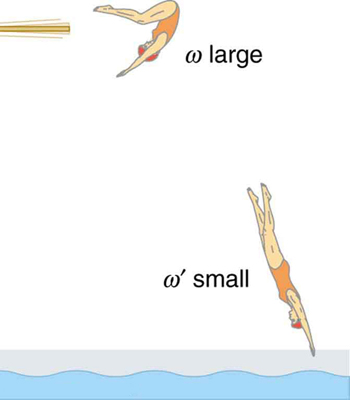
350 CHAPTER 10 | ROTATIONAL MOTION AND ANGULAR MOMENTUM
Figure 10.34 A child may jump off a merry-go-round in a variety of directions.
15. Suppose a child gets off a rotating merry-go-round. Does the angular velocity of the merry-go-round increase, decrease, or remain the same if:
(a) He jumps off radially? (b) He jumps backward to land motionless? (c) He jumps straight up and hangs onto an overhead tree branch? (d) He
jumps off forward, tangential to the edge? Explain your answers. (Refer to Figure 10.34).
16. Helicopters have a small propeller on their tail to keep them from rotating in the opposite direction of their main lifting blades. Explain in terms of
Newton’s third law why the helicopter body rotates in the opposite direction to the blades.
17. Whenever a helicopter has two sets of lifting blades, they rotate in opposite directions (and there will be no tail propeller). Explain why it is best to
have the blades rotate in opposite directions.
18. Describe how work is done by a skater pulling in her arms during a spin. In particular, identify the force she exerts on each arm to pull it in and the
distance each moves, noting that a component of the force is in the direction moved. Why is angular momentum not increased by this action?
19. When there is a global heating trend on Earth, the atmosphere expands and the length of the day increases very slightly. Explain why the length
of a day increases.
20. Nearly all conventional piston engines have flywheels on them to smooth out engine vibrations caused by the thrust of individual piston firings.
Why does the flywheel have this effect?
21. Jet turbines spin rapidly. They are designed to fly apart if something makes them seize suddenly, rather than transfer angular momentum to the
plane’s wing, possibly tearing it off. Explain how flying apart conserves angular momentum without transferring it to the wing.
22. An astronaut tightens a bolt on a satellite in orbit. He rotates in a direction opposite to that of the bolt, and the satellite rotates in the same
direction as the bolt. E












